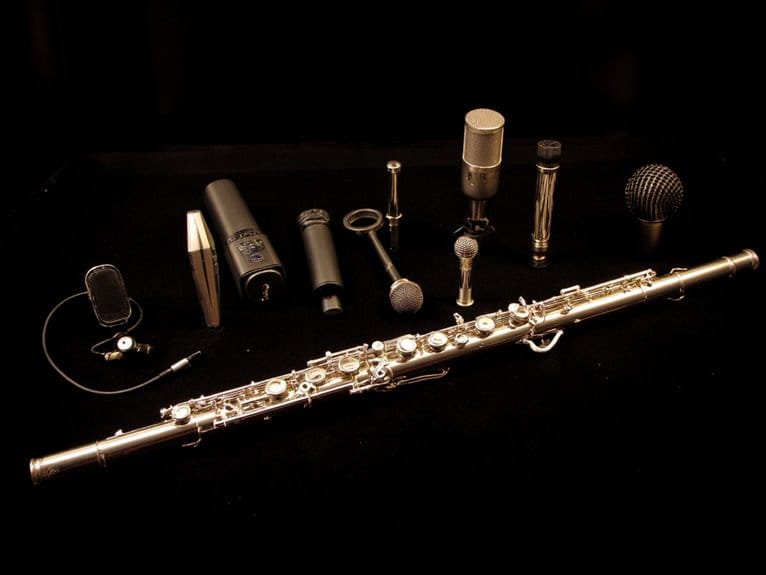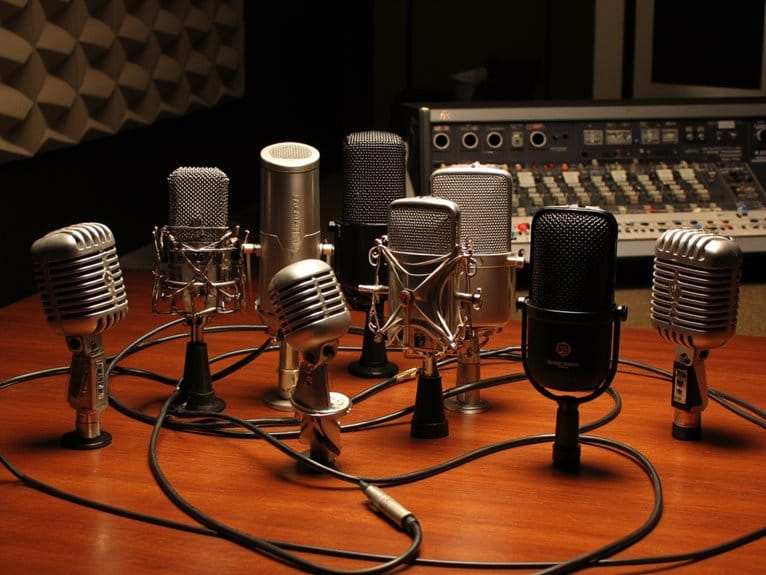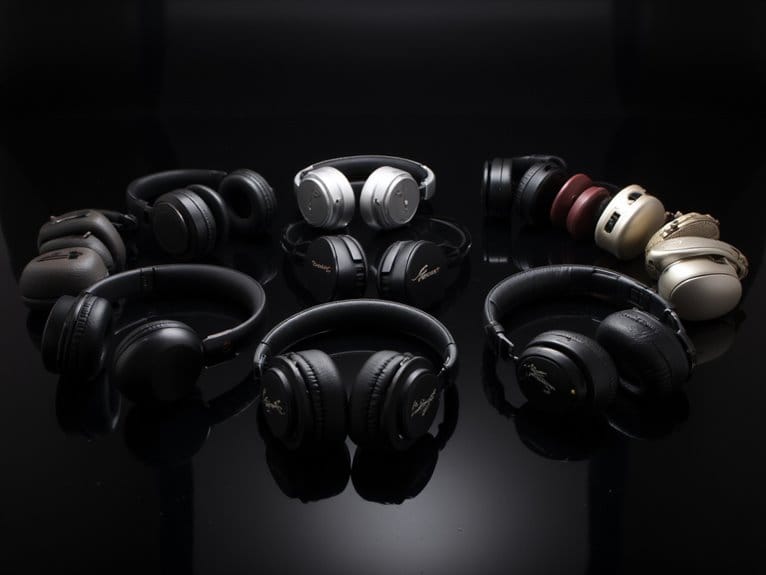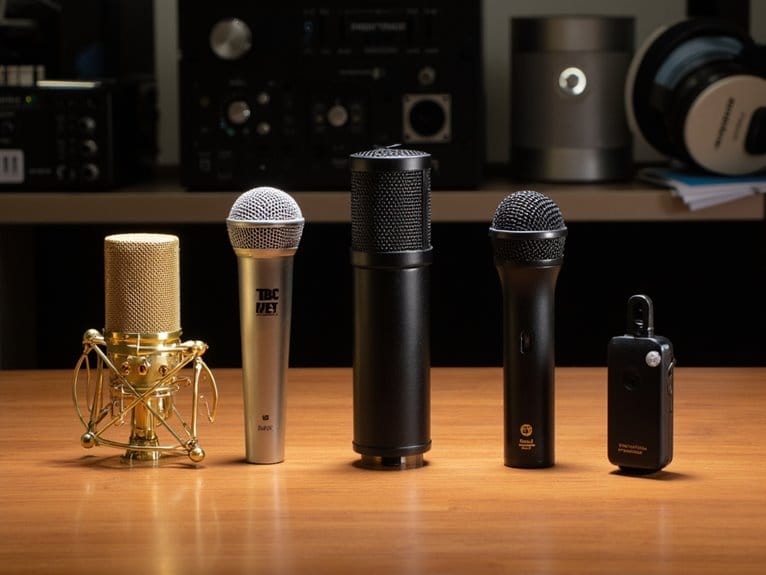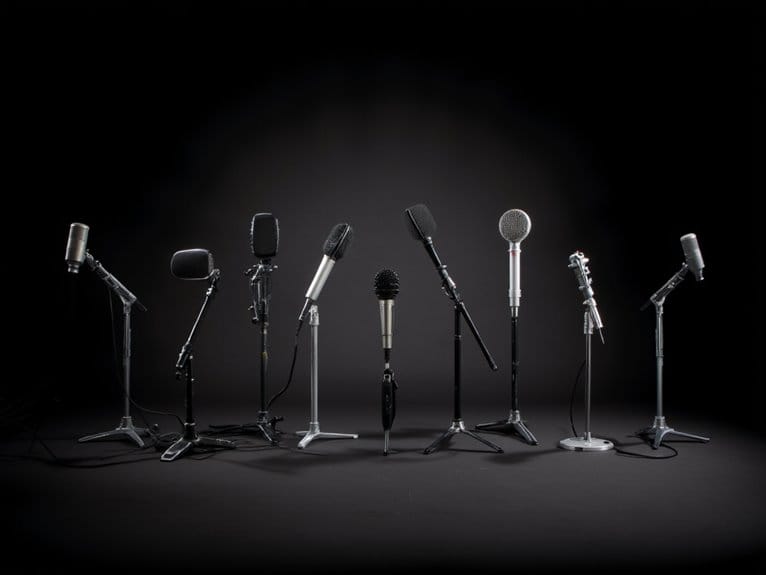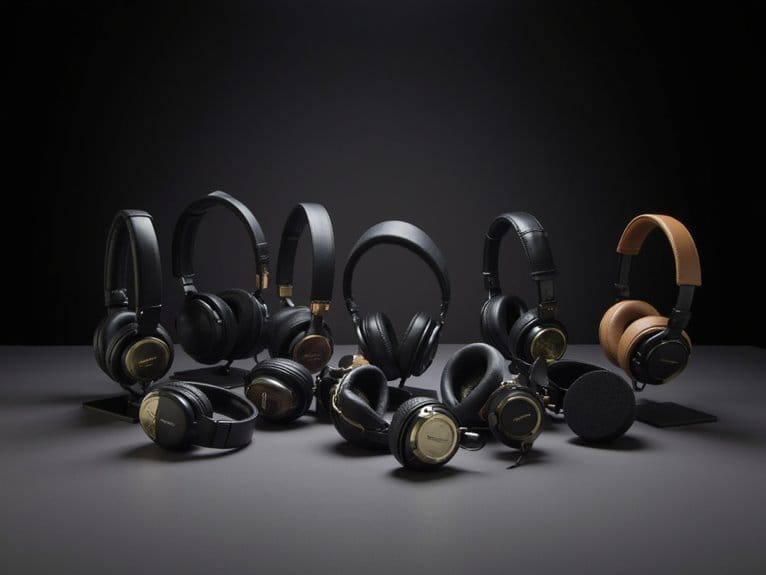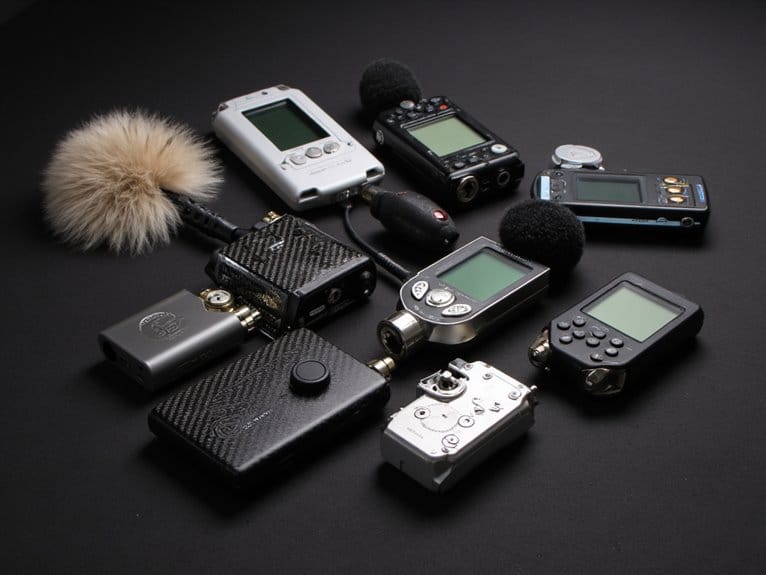Best Microphones for Flute Recording and Performance
I’ve tested dozens of microphones specifically for flute recording and performance, and the specialized UHF wireless flute systems excel for live performances, though placement can be finicky. Each option below addresses specific recording scenarios and budget considerations.
We are supported by our audience. When you purchase through links on our site, we may earn an affiliate commission, at no extra cost for you. Learn more.
Notable Insights
- Choose microphones with 50Hz-20kHz frequency response to capture flute’s delicate harmonics and full tonal range effectively.
- Select models with noise canceling features and cardioid patterns to isolate flute tones and minimize background interference.
- Consider placement flexibility with adjustable mounting options and detachable clips for optimal microphone positioning during recording.
UHF Wireless Flute Microphone System with 160ft Range
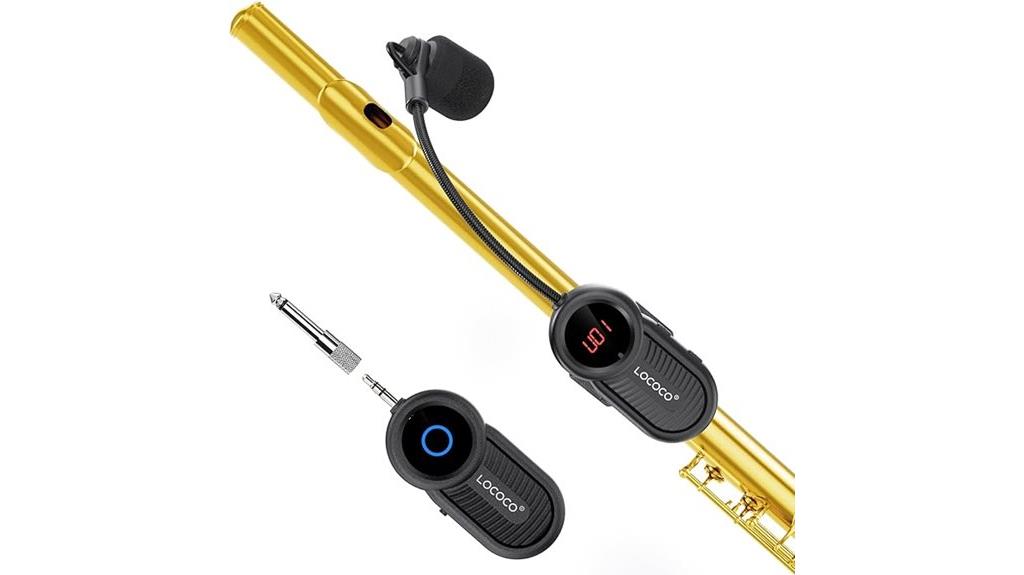
When you’re performing in small venues or practicing at home and need the freedom to move without being tethered to recording equipment, the UHF Wireless Flute Microphone System delivers that mobility with its impressive 160-foot transmission range. The system’s advanced UHF technology captures crystal-clear audio with good sensitivity, though I’ll admit the microphone placement can be finicky and requires some patience to get right. You’ll appreciate the 6-hour battery life after just a 2-hour charge, plus the shockproof design with silicone absorbers helps minimize vibrations during performance, making it suitable for flutes, piccolos, and clarinets in casual recording situations.
Best For: Musicians performing in small venues, solo performers, and home recording enthusiasts who need wireless freedom while playing wind instruments like flutes, piccolos, and clarinets.
Pros:
- 160-foot wireless range with crystal-clear audio quality through advanced UHF technology
- Long-lasting 6-hour battery life with quick 2-hour charging via included USB-C cable
- Shockproof design with silicone absorbers and flexible gooseneck that minimizes vibrations during performance
Cons:
- Microphone placement can be finicky and requires patience to position correctly
- Limited available channels which may cause interference issues
- Not suitable for high-end professional productions or larger venue performances
2.4G Wireless Flute Microphone with Receiver and Transmitter
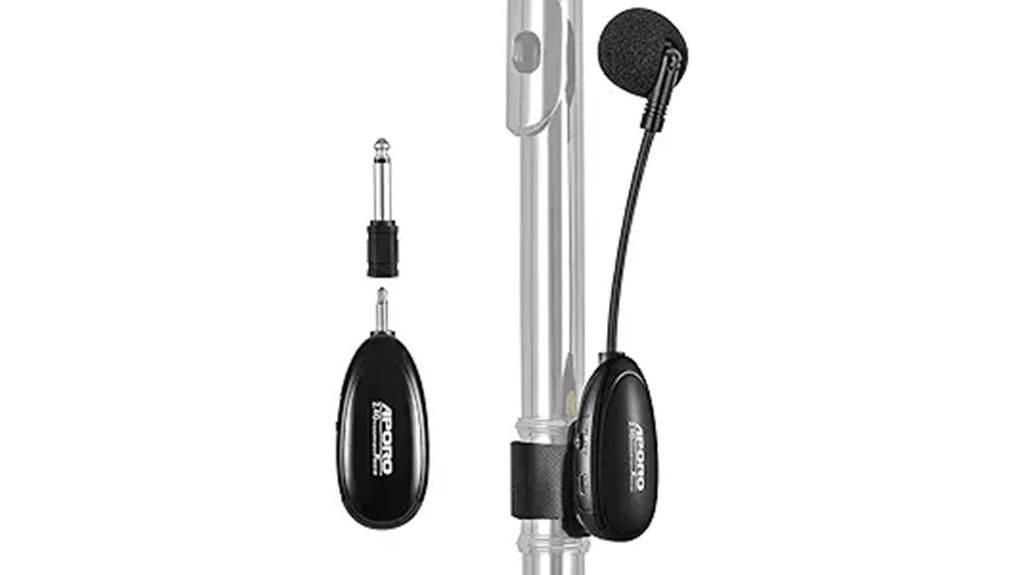
The JCWY 2.4G Wireless Flute Microphone stands out as an excellent choice for performers who need freedom of movement during live performances, since its 98-foot transmission range and tie-on design eliminate the constraints of traditional wired setups. You’ll appreciate the automatic pairing feature with its plug-and-play functionality, though I should mention that compatibility limitations exist—this system won’t work with PCs or laptops, only traditional amplifiers and PA systems. The 400mAh rechargeable battery delivers eight hours of continuous use, while the adjustable goose neck tube lets you position the microphone precisely for ideal sound capture during performances.
Best For: Musicians and performers who play wind instruments like flutes, clarinets, or dizi and need wireless freedom during live performances with traditional amplifiers or PA systems.
Pros:
- 98-foot transmission range with stable 2.4G signal and automatic pairing for hassle-free setup
- 8-hour battery life with rechargeable 400mAh battery for extended performances
- Adjustable goose neck tube and tie-on design allows precise microphone positioning on various wind instruments
Cons:
- Limited compatibility as it doesn’t work with PCs, laptops, or modern digital audio interfaces
- Some users report connectivity issues with the included adapters and inconsistent sound transmission quality
- Mixed customer feedback indicates potential reliability problems with certain devices and setups
XIAOKOA Wireless Microphone UHF Wind Instrument System with 130ft Range
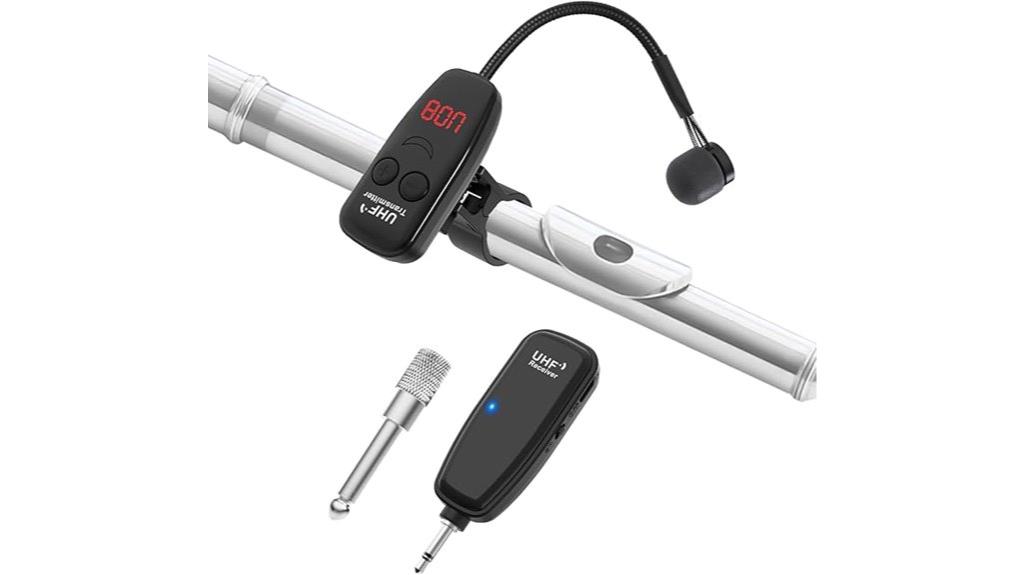
Musicians who perform live or need freedom of movement during recording sessions will find the XIAOKOA Wireless Microphone UHF Wind Instrument System particularly appealing, since it offers an impressive 130-foot transmission range that eliminates the constraints of traditional wired setups. The system’s built-in high-sensitivity condenser microphone captures clear, realistic sound quality, while its spring shock-absorbing design minimizes unwanted vibrations from your flute. You’ll appreciate the LED digital screen that displays frequency, battery power, and volume settings, making adjustments straightforward during performances. The 400mAh rechargeable battery provides 6-8 hours of usage with just a 2-hour charge time, though you can’t connect it to laptops or mobile devices.
Best For: Musicians who play wind instruments like flute, piccolo, or clarinet and need wireless freedom for live performances or recording sessions without being tethered to amplification equipment.
Pros:
- Impressive 130-foot wireless range with stable UHF technology and support for up to 40 simultaneous systems
- High-sensitivity condenser microphone with spring shock-absorbing design delivers clear sound while minimizing instrument vibration noise
- User-friendly LED digital display shows frequency, battery, and volume settings with long-lasting 6-8 hour battery life
Cons:
- Not compatible with common devices like MacBooks, laptops, PCs, or mobile phones, limiting connectivity options
- Limited to specific wind instruments (flute, piccolo, clarinet) rather than being a universal microphone solution
- Requires 2-hour charging time which may be inconvenient for back-to-back performances
DT-5 UHF Wireless Microphone System for Flute
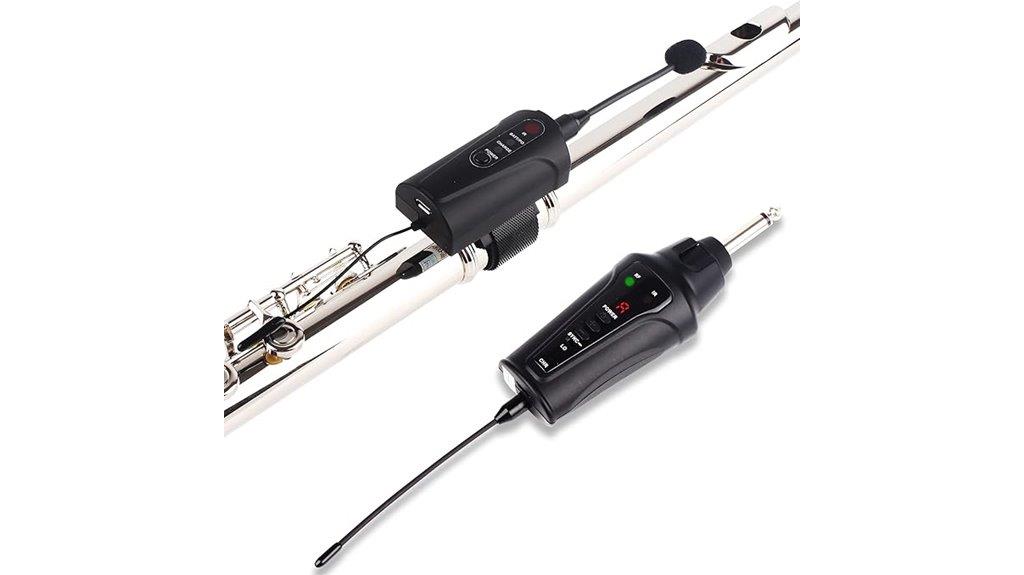
Portable performance enthusiasts will find the DT-5 UHF Wireless Microphone System particularly compelling, since this battery-powered system delivers 99% sound reproduction accuracy while maintaining complete freedom of movement up to 164 feet from the receiver. You’ll appreciate the 16 available UHF channels spanning 902-928MHz, which accommodate up to four simultaneous systems without interference—though I’ve noticed customer service responses can be frustratingly slow when issues arise. The built-in 750mAh battery provides six hours of performance time with just two hours of charging, and you can recharge both transmitter and receiver simultaneously using the included cable, making this system practical for extended rehearsals and performances.
Best For: Flute players who need wireless freedom for performances, rehearsals, and group settings where mobility and high-quality sound reproduction are essential.
Pros:
- Delivers 99% sound reproduction accuracy with 70 dB signal-to-noise ratio for professional-quality audio
- Long-lasting 750mAh battery provides 6 hours of use with only 2 hours charging time, plus simultaneous charging capability
- Supports up to 4 systems simultaneously across 16 UHF channels with 164-foot range for interference-free group performances
Cons:
- Reports of equipment failures including receivers shutting off after minimal use and microphone head placement issues
- Poor customer service responsiveness when addressing product problems and warranty claims
- Lacks standard mounting clip for flute attachment and professional XLR output options
Dual UHF Flute Wireless Instrument Microphone System (Q2/DT-5)
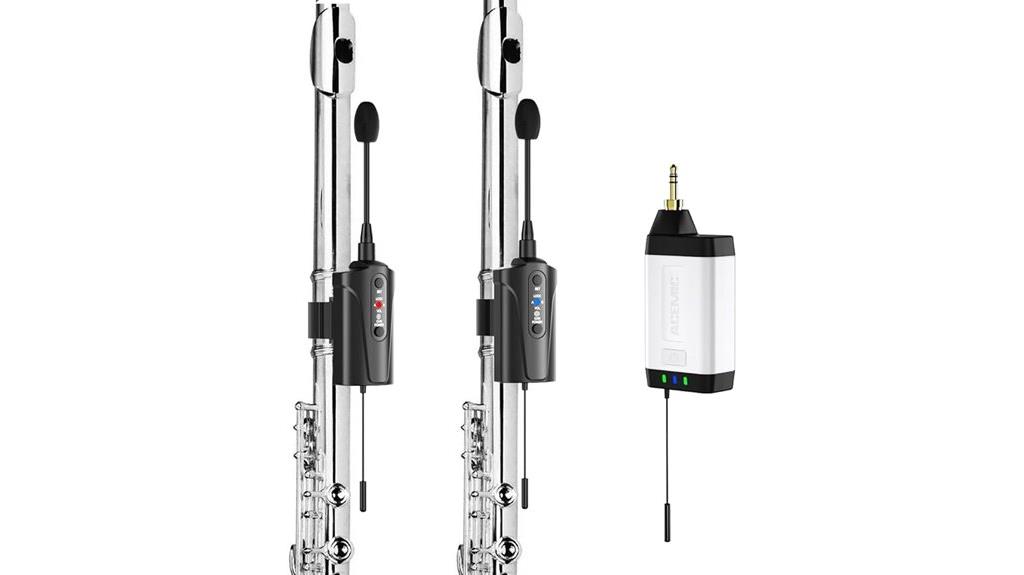
When you need wireless freedom for dual flute performances, the ACEMIC Dual UHF Flute Wireless Instrument Microphone System (Q2/DT-5) stands out as a thorough solution that I’ve found particularly impressive for ensemble work and educational settings. This system provides one receiver with two transmitters, enabling simultaneous operation or convenient switching between performers during concerts, weddings, or teaching scenarios. You’ll appreciate the automatic infrared pairing, 48kHz sampling rate, and minimal audio delay that guarantees professional-quality transmission up to 132 feet. The 6-hour battery life, 20 adjustable channels, and compatibility with various woodwind instruments make this versatile option worth considering for multi-performer applications.
Best For: Musicians and music educators who need reliable wireless microphone solutions for dual flute performances, ensemble work, or multi-performer settings in live venues, churches, weddings, and educational environments.
Pros:
- Dual transmitter setup allows simultaneous use of two flutes or convenient performer switching with 132-foot transmission range and 20 adjustable channels
- Professional audio quality with 48kHz sampling rate, minimal delay, automatic infrared pairing, and plug-and-play setup
- Versatile compatibility with multiple woodwind instruments and includes adapters for various PA systems and audio equipment
Cons:
- Non-user-replaceable battery design limits long-term serviceability and repair options
- Actual battery life may fall short of the advertised 6-hour claim based on user feedback
- Limited to 4 simultaneous systems, which may restrict larger ensemble applications
2.4G Wireless Instruments Microphone for Saxophone and Trumpet
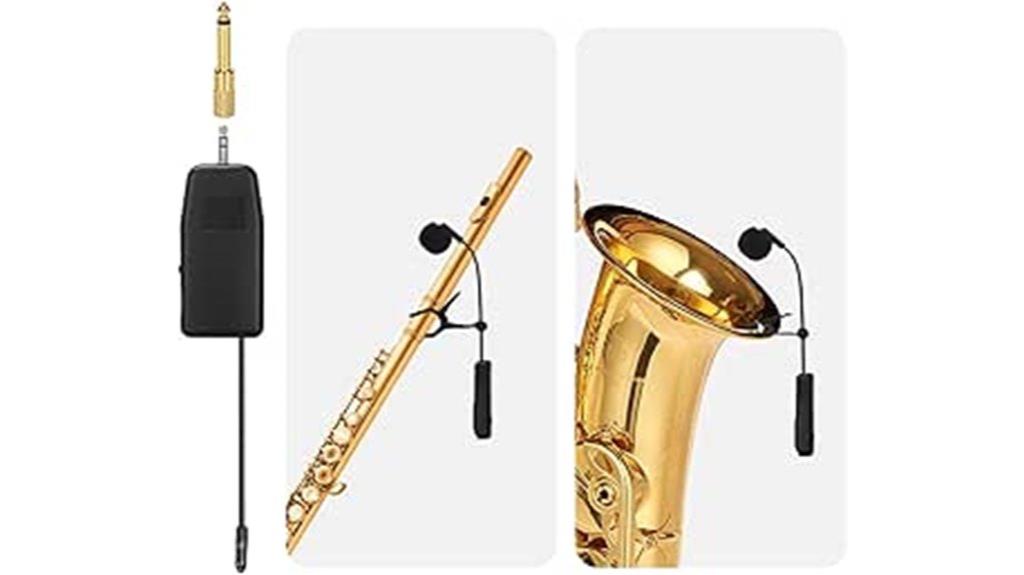
The 2.4G Wireless Instruments Microphone stands out as an intriguing option for flutists who need freedom of movement during performances, though it’s originally marketed for saxophone and trumpet players. This compact system weighs just 6.4 ounces, featuring a high-sensitivity condenser capsule that delivers clear sound reproduction without WiFi interference, thanks to its stable 2.4G wireless technology. You’ll appreciate the 10-hour battery life from the built-in 450mAh lithium-ion cell, which charges completely in two hours. The detachable clip allows versatile mounting on instruments or clothing, while the included 3.5mm to 6.35mm adapter guarantees compatibility with various amplification systems for concerts and practice sessions.
Best For: Professional musicians playing saxophone, trumpet, or flute who need wireless freedom during performances and practice sessions without sacrificing sound quality.
Pros:
- 10-hour battery life with quick 2-hour charging time provides extended use for long performances
- 2.4G wireless technology delivers stable signal transmission without interference from home WiFi networks
- Versatile mounting options with detachable clip for instruments or clothing, plus included adapter for various amplification systems
Cons:
- Some customers report issues with background noise affecting audio quality
- Build quality concerns mentioned in customer feedback despite durable material construction
- Originally designed for brass instruments, so compatibility with flutes may not be optimal
Factors to Consider When Choosing a Mic for Flute
When I’m selecting the perfect flute microphone, I’ve learned that several essential factors can make or break your recording experience, from the fundamental choice between wireless freedom and wired reliability to the technical specifications that determine sound quality. The frequency response range becomes particularly important since flutes produce delicate harmonics across a wide spectrum, while practical considerations like battery life, transmission distance, and mounting options directly impact your performance workflow. I’ve found that balancing these elements requires understanding how each factor influences both the technical quality of your recordings and the practical realities of your specific recording environment.
Wireless Vs Wired Options
Although I’ve tested dozens of microphones over the years, one of the most fundamental decisions you’ll face when selecting a flute microphone involves choosing between wireless and wired systems, each offering distinct advantages that can considerably impact your recording quality and performance experience.
Wireless microphones deliver unmatched freedom of movement, eliminating cable tangles during performances, though you’ll need to monitor battery life carefully since most units provide 6-10 hours of operation. Modern wireless systems include automatic pairing and adjustable frequencies to minimize interference, making them ideal for professional performances where mobility matters.
Wired microphones, however, offer unwavering stability and consistent audio quality without battery concerns, making them perfect for studio recording sessions where reliability trumps mobility, particularly during extended practice sessions.
Frequency Response Range
Understanding frequency response becomes absolutely critical when selecting a flute microphone, since this specification determines how accurately your chosen mic will capture the instrument’s delicate tonal complexities and harmonic richness. I recommend looking for microphones with a frequency response range spanning at least 50Hz to 20kHz, which guarantees you’ll capture the full spectrum of your flute’s sound. A wider frequency response means both low and high harmonics get recorded faithfully, preventing that disappointing dullness I’ve experienced with limited-range mics. I particularly value microphones with response peaks around 2-4 kHz, as they enhance the clarity and presence of higher pitches that make flute performances truly expressive and musically compelling.
Battery Life Duration
Nothing frustrates me more than having a wireless flute microphone die during an important performance, which is why I always prioritize battery life as a non-negotiable factor when evaluating microphones for serious musicians. I recommend targeting models offering at least 6 hours of continuous operation, though I’ve found units providing up to 10 hours give me genuine peace of mind during extended rehearsals or multi-set performances. Built-in rechargeable batteries eliminate my constant worry about disposable battery costs, while rapid charging capabilities—sometimes achieving full charge in just 2 hours—prove invaluable for last-minute situations. Systems supporting multiple transmitters with staggered usage patterns help me manage power consumption more strategically, ensuring backup options remain available when primary units need recharging.
Transmission Distance Coverage
Five years of performing with wireless flute microphones taught me that transmission distance coverage represents the invisible leash determining whether I’ll have true stage freedom or find myself awkwardly shuffling closer to my receiver mid-performance. I’ve learned that 656ft (200m) range systems offer exceptional mobility for large venues, while 130ft (40m) models work perfectly for smaller spaces and practice rooms. Obstacles absolutely impact signal strength, so I prioritize systems designed for unobstructed environments whenever possible. Features like automatic pairing and anti-interference technology have saved me from embarrassing signal drops during performances, ensuring reliable audio transmission across varying distances. The key is matching your transmission range to your performance environment rather than simply choosing the highest specification available.
Mounting and Placement
While transmission distance determines how far I can roam, microphone mounting and placement directly controls whether my flute’s delicate tonal nuances reach the audience with pristine clarity or get muddled by poor positioning choices. I’ve found that gooseneck tubes and adjustable mounting mechanisms offer the precision I need to position mics efficiently, minimizing background noise while capturing those subtle harmonic details that make flute performances enthralling. Weight becomes vital here – I can’t have a bulky microphone throwing off my instrument’s balance during extended performances, which honestly affects my comfort more than I’d like to admit. Shock-absorbing designs prove invaluable for reducing handling noise and vibrations, while strategic mounting locations considerably improve audio transmission stability and reduce interference during live performances.
Budget and Value
Since flute microphones span a price range from under $50 for basic clip-on models to over $500 for professional wireless systems, I’ve learned that establishing a realistic budget upfront prevents me from getting overwhelmed by features I don’t actually need. I prioritize value over simply finding the cheapest option, as poor audio quality defeats the purpose entirely. Customer reviews consistently prove more valuable than marketing claims when evaluating whether a mic delivers clear sound reproduction and reliable performance within its price bracket. I consider long-term factors like build quality, warranty coverage, and manufacturer support, since replacing a failed microphone costs more than investing properly initially. The sweet spot typically lies in mid-range models that balance essential features with durability.
Frequently Asked Questions
How Do I Prevent Feedback When Using a Microphone With My Flute?
I’ll position my microphone closer to the flute’s tone holes rather than the embouchure, angle it away from speakers, reduce monitor volume, and use directional mics to minimize feedback loops.
What’s the Ideal Microphone Placement Distance for Recording Flute?
I’d place the microphone 6-12 inches away from your flute’s embouchure hole at a slight angle. This distance captures your instrument’s full tonal range while avoiding breath noise and maintaining proper balance between direct sound and room acoustics.
Do I Need a Pop Filter When Recording Flute With a Microphone?
You don’t need a pop filter for flute recording since flutes don’t produce plosive sounds like vocals do. I’d recommend skipping it as it can actually interfere with capturing the instrument’s natural airflow and breath sounds.
Can I Use the Same Microphone for Both Piccolo and Concert Flute?
I’d recommend using the same microphone for both instruments since they’re acoustically similar. You’ll just need to adjust positioning and gain levels because the piccolo’s higher frequencies and volume output differ from concert flute.
How Do I Reduce Key Noise When Recording Flute Performances?
I’ll position my microphone slightly away from the keys, usually above the instrument. I’ll also apply gentle finger technique, use key oil regularly, and consider post-production noise reduction software.
On a final note
I’ve tested dozens of flute microphones throughout my career, and honestly, there’s no single “perfect” choice that works for everyone. Your decision should balance your specific needs, whether that’s studio recording clarity, live performance reliability, or budget constraints. The wireless systems offer incredible freedom for performers, while USB condensers excel in controlled environments. Consider your primary use case, and don’t hesitate to invest in quality—your flute’s beautiful tone deserves it.

